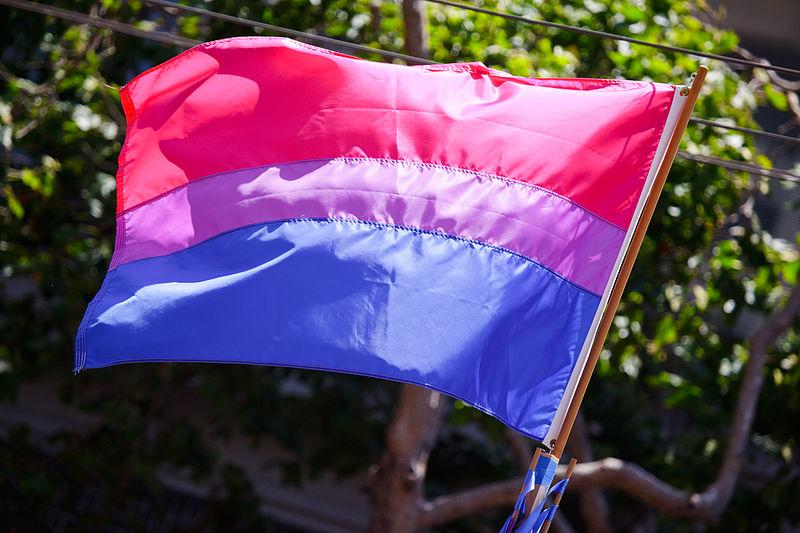Christopherson: Where Were the Bi Flags at Campus Pride Week?
October 30, 2019
Update: A Pride Week Committee member reached out to our staff to let us know there was a bi flag on the walkway during Campus Pride Week. We’ve left this article as is since the arguments still stand, but we acknowledge there was no real error on the committee’s part and thank them for their attention to detail.
Earlier this October, the University of Utah celebrated Campus Pride Week. I saw rainbows; pink, blue and white transgender flags; and purple, black, white and yellow stripes representing gender non-conforming and non-binary people. Still, as I scanned the rows of pride flags stretching behind the Union on my way to class, I couldn’t find what I was looking for among the colors. Whoever planned the display clearly intended it to be representative of the entire queer community — I hadn’t seen a non-binary flag before or even known there was one — so their glaring omission, I thought, must have been conscious. Why did they leave out the bisexual flag?
One likely answer is that this well-intentioned display organizer assumed that bisexuality was adequately represented by the umbrella of the rainbow flag. That reasoning is completely understandable — but I’m bisexual, and I can tell you it matters that we have our own flag.
It matters for the same reasons Bi Visibility Day matters. Broadly speaking, being bisexual is not the same as being gay or lesbian. There are a handful of important experiences that bisexual people might cite to as examples of the things we might go through that people with other queer identities do not. Some of this includes a disbelief in the existence of bisexuality as a legitimate orientation, discrimination toward bisexuals within the queer community and unfair misconceptions about bisexual people’s capacity for romantic fidelity.
The most prominent distinction in my experience, though, is the erasure and imposter syndrome engendered — or at least confirmed — by things like, say, a lack of bi flags on campus in a week dedicated to celebrating queer people and queerness. Part of this is the flip side of what we call “passing privilege.” I read as straight, so I benefit from the social protections that come with being straight. As long as I date men and ultimately end up with one, I don’t have to worry about being harassed in public or at work, about being preached at or disowned by my religious community or about losing loved ones over my sexuality.
From one perspective, being bisexual can be extremely convenient — a version of queerness where the trauma, loss and prejudice almost universally experienced by other members of the LGBTQ+ community might not occur. There’s a degree of legitimacy to that take — I’m aware and extremely grateful I haven’t been made to suffer in that way because of my sexual orientation. On the other hand, reading as straight has raised painful questions for me that are challenging in their own right. What right do I have to consider myself part of the queer community? What right do I have to feel hurt by the anti-LGBTQ+ rhetoric and policies of my church when I can simply marry a man and continue operating as straight in that organization for the rest of my life? If I do that, does it even matter that I identify as bisexual?
I change my mind, too, about whether my sexuality is important to my identity as a whole. If it isn’t, and I’m happy enough having romantic experiences and relationships with men, is it worth the risks associated with publicly dating women? Why should I go to the trouble — and the potential trauma — of coming out to everyone in my life? Would I truly be happier being publicly out than I am benefiting from the privileges of passing as straight? Passing, in other words, contributes as much to my sense of invisibility as a bisexual person as it does my protection from discrimination and external harm.
I can’t speak to the full range of experiences bisexual people have in coming to terms with their sexuality, but the point of discussing my own here is to show that they are vastly different from those of gay and lesbian people. Statistics validate that viewpoint. A recent report by the Pew Research Center states that “bisexual adults are much less likely than gays and lesbians to be ‘out’ to the important people in their lives” — probably because we have to grapple with the pros and cons of our invisibility in totally unique ways.
None of this is to say that being bisexual is harder than being another queer identity, but it is different. Leaving the bisexual flag out of Campus Pride Week, or any other event or discussion of queer pride — even down to the emoji keyboard — sends two messages that directly conflict with the purposes of celebrating pride in the first place. First, it reinforces my sense (and, I imagine, many others’) of existing outside the bounds of the queer community, that I am “not gay enough” to qualify. Second, it erases the realities of my experience by treating it as simply part of the broader gay experience, forcing it under the rainbow umbrella when it’s much better suited to a raincoat. Of all places, we deserve to be represented, visibly, in our school’s string of pride flags one week out of the year.









Bill • Oct 31, 2019 at 5:24 am
So did you ever bother to ask the organizer(s)?
Robyn Ochs • Oct 30, 2019 at 7:24 pm
Nain, thank you for this thoughtful exploration of the importance of bi visibility and the differences between bi and lesbian/gay experience. While there is a substantial overlap, they are not identical.
it is important that we recognize that passing (and being passed over) can be both a privilege and a terrible burden. It took me five long years to gather the courage to come out, and I found silence suffocating. When I finally came out I felt such a profound sense of relief.
I am a writer and a speaker on this subject (I spoke in SLC last June during Pride month), and I just want to validate your experience. I hope that the next time the University of Utah celebrates Pride Week, there are bi pride flags hanging proudly alongside the others.
Warm regards from Boston,
Robyn Ochs
@robynochs, robynochs.com